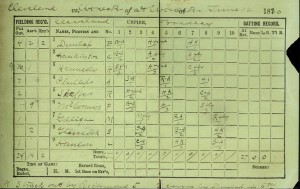Baseball seems simple but on the surface it is very complicated. Many of the baseball rules are very subtle. But there are some basics:
Nine innings.
Each team comes up to bat once, beginning with the visiting team.
Each team is at bat until there are three outs.
The team that is ahead after nine complete innings is the winner.
If the score is equal after nine innings, the game goes into extra innings.
In extra innings, a complete inning is played. If there is a team that is ahead at the end of the extra inning, that team is declared the winner of the game. Otherwise, another inning is played until there is a winner at the end of that complete inning.
The fewest number of “at bats” in any one game would, therefore, be 27: Nine innings, 3 batters per inning.
When a pitcher is pitching against a team and there are 27 up and 27 down, he has pitched a “perfect game“.
The scorecard for Lee Richmond’s Perfect Game
Another special type of game is called a “no no“. This refers to a game in which there are no hits and no runs. If there are no hits and no runs, then why isn’t it a perfect game? In a “no no”, a batter can be walked*, in which case he will reach first base and ruin an otherwise perfect game.
In American Major League baseball history, by the current definition of “a perfect game”, there have been 20 official perfect games. There have been several unofficial ones.
It is thrilling to watch a perfect game – and my baseball timing has been incredible on several occasions: I saw Dave Cone’s perfect game in 1999. I also saw John Lester’s no hitter (a “no no”) in 2008, which was also thrilling.
Click here to see video highlights of David Cone’s perfect game.
*In another blog post, we will discuss the ways in which a batter is declared to be out.

Leave a Reply